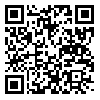Volume 18, Issue 1 (Vol.18, No.1, Spring 2022 2022)
irje 2022, 18(1): 45-58 |
Back to browse issues page
Download citation:
BibTeX | RIS | EndNote | Medlars | ProCite | Reference Manager | RefWorks
Send citation to:



BibTeX | RIS | EndNote | Medlars | ProCite | Reference Manager | RefWorks
Send citation to:
Bagheri A, Saadati M, Zanjari N, Shabak A. Study of Determinants of Self-Assessed Health of Elderly People in Tehran Using Generalized Structural Equation Model. irje 2022; 18 (1) :45-58
URL: http://irje.tums.ac.ir/article-1-6686-en.html
URL: http://irje.tums.ac.ir/article-1-6686-en.html
1- Associate Professor of Applied Statistics, National Institute for Population Research, Tehran, Iran
2- Associate Professor of Biostatistics, National Institute for Population Research, Tehran, Iran ,mahsa.saadati@gmail.com
3- Assistant Professor of Iranian Research Centre on Aging, University of Social Welfare and Rehabilitation Sciences, Tehran, Iran
4- Assistant Professor of Applied Statistics, Data Processing and Information Research Group, Statistics Research Institute, Tehran, Iran
2- Associate Professor of Biostatistics, National Institute for Population Research, Tehran, Iran ,
3- Assistant Professor of Iranian Research Centre on Aging, University of Social Welfare and Rehabilitation Sciences, Tehran, Iran
4- Assistant Professor of Applied Statistics, Data Processing and Information Research Group, Statistics Research Institute, Tehran, Iran
Abstract: (1339 Views)
Background and Objectives: Considering the growing trend of aging in Iran, it is necessary to study the factors affecting the health of elderly people. The main purpose of this study was to investigate demographic, social, and economic determinants of self-assessed health of elderly people in Tehran using generalized structural equation model (GSEM).
Methods: The data of the present study was obtained from a cross-sectional study in which 598 elderly people aged 60 years and over were selected from 22 districts of Tehran in 20151394 using stratified multi-stage sampling method and a researcher-made questionnaire was completed for them. The reliability of the questionnaire was also confirmed using and time consistency. To study the determinants of self-assessed health of elderly people, WLSMV and ULSMV estimators of GSEM were compared in Mplus (7.3).
Results: Based on the goodness-of-fit indices, the ULSMV estimator was selected to evaluate factors affecting the self-assessed health of elderly people (RMSEA=0.02, CFI=0.951 and TLI=0.962). The self-assessed health ranks of married and employed elderly people were higher than single (P-value=0.022) and unemployed (P-value=0.048) ones, respectively. An increase in spirituality (P-value=0.016), physical and mental health (P-value=0.001), and health-oriented behavior (P-value=0.016) increased the standard score of self-assessed health of elderly people. Physical and mental health played a complete mediating role in relationships of gender (P-value=0.014), marital status (P-value=0.040), education level (P-value=0.039), self-reported socio-economic status (good/ P-value=0.013 and middle/P-value=0.017) and number of diseases (P-value=0.001) with self-assessed health of elderly people.
Conclusion: According to the results, for policy-making in the field of geritrics, special attention should be paid to structural variables like gender, marital status, education level, and self-reported socio-economic status in addition to physical and mental health.
Methods: The data of the present study was obtained from a cross-sectional study in which 598 elderly people aged 60 years and over were selected from 22 districts of Tehran in 20151394 using stratified multi-stage sampling method and a researcher-made questionnaire was completed for them. The reliability of the questionnaire was also confirmed using and time consistency. To study the determinants of self-assessed health of elderly people, WLSMV and ULSMV estimators of GSEM were compared in Mplus (7.3).
Results: Based on the goodness-of-fit indices, the ULSMV estimator was selected to evaluate factors affecting the self-assessed health of elderly people (RMSEA=0.02, CFI=0.951 and TLI=0.962). The self-assessed health ranks of married and employed elderly people were higher than single (P-value=0.022) and unemployed (P-value=0.048) ones, respectively. An increase in spirituality (P-value=0.016), physical and mental health (P-value=0.001), and health-oriented behavior (P-value=0.016) increased the standard score of self-assessed health of elderly people. Physical and mental health played a complete mediating role in relationships of gender (P-value=0.014), marital status (P-value=0.040), education level (P-value=0.039), self-reported socio-economic status (good/ P-value=0.013 and middle/P-value=0.017) and number of diseases (P-value=0.001) with self-assessed health of elderly people.
Conclusion: According to the results, for policy-making in the field of geritrics, special attention should be paid to structural variables like gender, marital status, education level, and self-reported socio-economic status in addition to physical and mental health.
Keywords: Self-assessed health of elderlies, Generalized structural equation model, Physical and mental health, Tehran
Type of Study: Research |
Subject:
Special
Received: 2021/02/20 | Accepted: 2022/05/31 | Published: 2022/05/31
Received: 2021/02/20 | Accepted: 2022/05/31 | Published: 2022/05/31
Send email to the article author
| Rights and permissions | |
 |
This work is licensed under a Creative Commons Attribution-NonCommercial 4.0 International License. |





